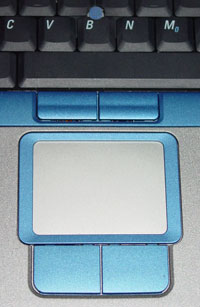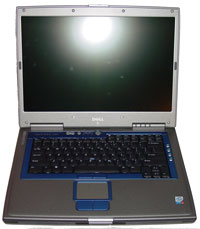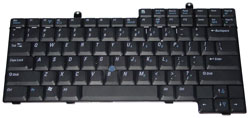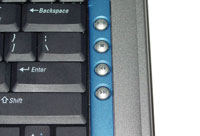Dell Inspiron 8600: Mobile Multimedia goes Wide Screen
by Andrew Ku on October 9, 2003 1:00 AM EST- Posted in
- Laptops
Construction — Build, Appearance, Size
As the successor to the Inspiron 8500, the Inspiron 8600 has the same basic form as its predecessor. However, it is uses Centrino components instead of mobile components. For example, the Inspiron 8600 uses a Pentium-M processor in contrast to the 8500's Pentium 4-M processor. In traditional Dell fashion, the Inspiron 8600 comes in a Moonlight Silver and Venice Blue color scheme. To access the notebook, push the single clip that secures the lid and open.Click to enlarge.
Upon access, the 8600 reveals a 15.4" WUXGA (1920x1200) screen, which is one of three options available for the Inspiron 8600 and 8500. Since Dell offers customizable systems, there are two other available options: WXGA and WSXGA+ with the latter being the default option for the Inspiron 8600/8500. The two other available options use the same screen size, 15.4", but are limited to lower resolutions: 1280x800 and 1680x1050, respectively. Considering the size of the notebook, a 15.4" wide screen is good choice for Dell to make, as a larger wide aspect screen can't really fit. Our recommendation would be to stick with the WSXGA+ (1680x1050) as the bottom limit for your configuration, as a WXGA (1280x800) looks a bit odd on a 15.4" wide aspect screen.
For those looking for a large amount of workspace or that extra kick for watching movies, the 15.4" WUXGA (1920x1200), which is the option we personally prefer, won't disappoint you. To be specific, the 15.4" WUXGA provides 20% more desktop surface than a typical 15.4" UXGA, and with UltraSharp LCD technology, the 15.4" WUXGA gives us wider and clearer viewing angles.
In order for Dell to fit the 15.4" panel on the Inspiron 8600, the notebook has a wider berth that we have yet to see many other notebooks surpass. Traditional notebooks have been square or at least near square in design, but with the wide screen panel, the Inspiron 8600 basic form is rectangular (3.3 inches greater in width than length). This gives the 8600 plenty of surface space to spare and carries over to keyboard layout.
Overall, Dell has gotten the keyboard down right. The rectangular form has given Dell plenty of surface space with which to work, and the 8600 is equipped appropriately with a full-sized keyboard. The control key is at the correct place on the keyboard (bottom left corner) and included dedicated arrow keys. The keyboard feels fairly standard, which we found to have a good response and a tactile feel.
Click to enlarge.
Since the notebook is offered as a multimedia platform, Dell has appropriately designed a few multimedia hotkeys for quick access. While the function key on the keyboard takes care of this for other notebooks, the dedicated keys provide simplified support.
Click to enlarge.
There are two methods to which mouse input is supplied, dubbed the “DualPoint” integrated pointing device. Like the Latitude D800, the “DualPoint” input system comprises of a touchpad and a track stick. The set of buttons for the touchpad are reasonably responsive, but we found the set for the track point a bit fickle. We would have liked to have seen a bit more response in them when we pressed down to enable a click. Still missing is a scroll button of sorts. This is also missing from the Inspiron 8500 and the 8200, which the 8600 succeeds.

There are four status LEDs on the monitor hinge. This is a good placement for the LEDs because it maintains visibility even when the monitor is closed, which provide status information on power, hard drive activity, battery state, and Bluetooth status. Additionally, this placement negates the need for an extra array of LEDs specifically to be visible when the monitor is closed. We especially liked the fade on the power and the battery state LEDs when they changed status. Instead of the light abruptly going on and off, the light would do a simple fade, which we found to add that little something extra.

Additional status LEDs are located above the keyboard and indicate key status (num lock, caps lock, and scroll lock). The system's power button is located to the right of the LEDs, and to the left is the mute button followed by a volume up and volume down button, which should come in handy when you are playing movies. The little divot above the caps lock (the middle LED) is actually the system microphone. This is a good placement in terms of keeping hands away from creating the unwanted rustling noise, but it also leaves it a bit too far away from the sound source (our mouth).

When the screen is visible, the 8600 exposes two of its cooling vents. The first of the two is located towards the back of the system, near the monitor, and to the left of the keyboard. This brings in cool air for the CPU fan, which lies directly below. The second vent is barely visible and is located directly below the monitor along the gap between the monitor and the system (between the two hinges). This is an exhaust vent for a second cooling fan that is for a separate component, which we will cover later on.













21 Comments
View All Comments
olberd - Wednesday, December 15, 2004 - link
I've bought a Dell 8600c and I'm wondering if I can use generic SODIMM 200pin RAM for it, or I must use the more expensive RAM from kingston specifically designed for it.Some computer resellers tell me that I must use the kingston RAM 5150 for Dell. But a Dell supporter told me that standard RAM will do as well.
I understand that some notebooks are made with customized RAM modules. This makes spare parts more expensive and thus makes it an interesting note to add in the review of a notebook computer.
Rune
Duddy - Friday, November 26, 2004 - link
I just purchased an 8600 from Dell.com and the option for a Mobility Radeon 9600 was there and I ordered it. :)VIDEO: 128MB DDR ATI's MOBILITY® RADEON? 9600 PROTURBO
Total came out to be around $1800 plus 20% off all Inspiron notebooks. I paid exactly $1,516.40.
akodi - Thursday, November 6, 2003 - link
I bought a dell 8500 last week and am typing on it currently, it is the most awesome laptop I have ever used, the screen is super sharp (15.4 sxga+) to tell you the truth 1900x1200 would be way too small, 1680x1050 is preemo, so much damn realestate. I had a centrino but wasn't too impressed (600m) battery life was not that much better than a standard p4m, perhaps only a difference of a half hour. Being a college student at Cal I believe the 8500 is perfect, because at the library there are many power outlets so battery life isn't an issue, also if you plug in a wlan card you can use it in the library without a hitch (preemo bandwidth). On the video card issue, I wouldn't want to play games on a laptop not because of the graphics but mainly for the sound quality...sigmatel in my opinion is not kosher on the ears. Long live the forums and dell stackable coupons.Andrew Ku - Tuesday, October 28, 2003 - link
Sony, doesn't sell in the same volumes as Dell. Toshiba was the first to market with the Go56x0 (we mentioned this in the M10 and NV31M head to head). However, this was mainly with the Japanese market. This is also the case with Sony, as they are not widespread domestically. We didn't say that the 8600 was the first with NV31M; we said it was the first mainstream laptop with NV31M. This is in the context of the domestic market and demographics.Anonymous User - Saturday, October 18, 2003 - link
Just wanted to correct an error in the article. The Dell is not the first laptop with the Geforce FX 5600go. In fact I'm typing on a laptop that has one in it right now - a laptop I bought 3 months ago. The Sony Vaio GRT170. Just thought I'd let you know.Anonymous User - Thursday, October 16, 2003 - link
Somebody know EUROCOM notebooks?? are they good quality? They have "nice" notebooks wit m10pAnonymous User - Thursday, October 16, 2003 - link
nice photoshop art in my opinion... otherwise Andrew Ku would aahve known this don't you think????Anonymous User - Wednesday, October 15, 2003 - link
http://forum.tt-hardware.com/uploads/pub_dell_pcac...This scan shows a Dell 8600 with a mobility Radeon 9600XT (128mb). It does not show up on any of the dell sites I visited (French, Dutch, English). Is this a hoax or a dream come true?
Anonymous User - Wednesday, October 15, 2003 - link
Whatever... Dell is bull....Anonymous User - Sunday, October 12, 2003 - link
I must apollogize Mr Ku , I do seem to be wrong on certain facts there , but for my interest , would you kindly explain where the term Molex comes into mbile processing ,as it also refers to the electrical connector for a hard drive(or so I have been told/taught ) . As for Mobile processing often been entirely diffrent park , doesn't a desktop replacement laptop like , say a dell 8600 user a Pentuim-M chip , which uses 478 PPGA Flip - chip 2 array , just likes its desktop brother , the same that can be found in certain laptops as well , ? and doesn't Laptops use 333MHz DDR -Ram (albiet in SO-DIMM format ) , latest GPU'S , 7200 RPM hardrives , and some even with RAID systems . Please would you clarify this , as I am not challenging you , just simply asking ?Bandwidth Boy